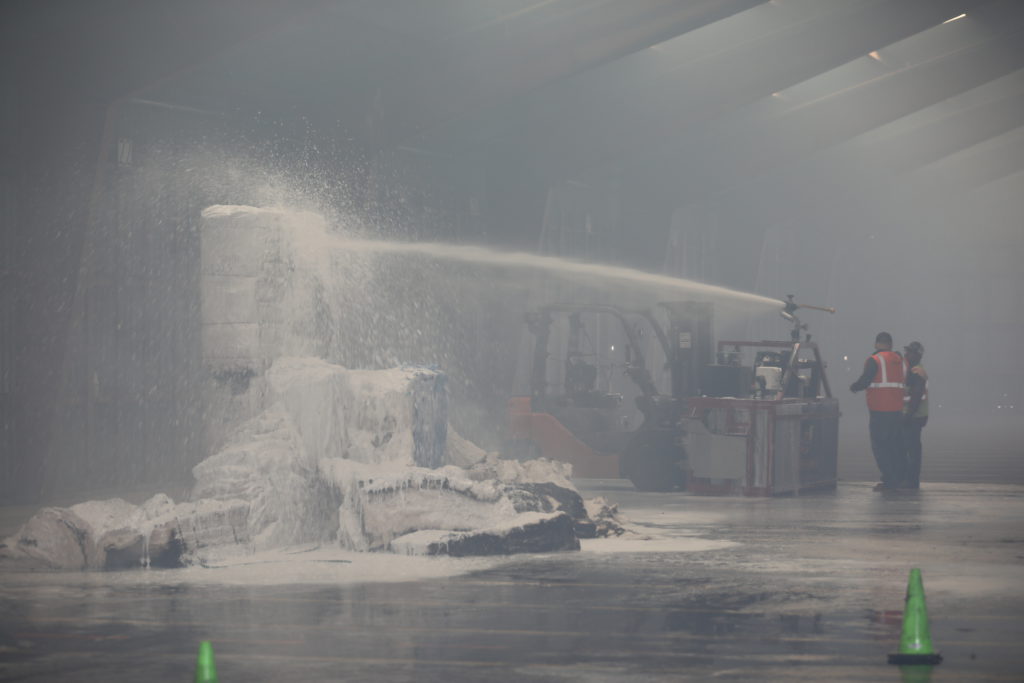by Blair White
 Fire is the number one risk of disastrous loss in cotton bales and cotton warehouse buildings. Warehouse fires are often caused by a “hot bale” that comes from the gin, but they can also be sparked by an equipment failure or natural weather event. It is a problem as old as the cotton industry itself. The PCCA Warehouse team partnered with the Fire Chief in Altus, Oklahoma, to proactively address this issue after experiencing a large warehouse fire in 2020. After some inventive brainstorming and problem solving, The FyreHawk was born. This innovation is a piece of fire-fighting equipment made especially for forklifts in cotton warehouses.
Fire is the number one risk of disastrous loss in cotton bales and cotton warehouse buildings. Warehouse fires are often caused by a “hot bale” that comes from the gin, but they can also be sparked by an equipment failure or natural weather event. It is a problem as old as the cotton industry itself. The PCCA Warehouse team partnered with the Fire Chief in Altus, Oklahoma, to proactively address this issue after experiencing a large warehouse fire in 2020. After some inventive brainstorming and problem solving, The FyreHawk was born. This innovation is a piece of fire-fighting equipment made especially for forklifts in cotton warehouses.
Altus Fire Chief Joe Buchanan consulted with PCCA to help tackle the problem. He spent some time at the Altus warehouse examining the working environment and employees to develop ideas for the FyreHawk system.
“I hung out at the plant for several days and was thinking, ‘They either need a big fire extinguisher or a little fire truck,’” Buchanan said. “I was trying to think that through. The whole time these lift trucks are driving by me with expert drivers, picking up cotton and putting it in the warehouse. I thought if we could build a fire-fighting box for them, then I’ve already got expert drivers and little fire trucks that fit in a warehouse. That’s how we came up with the FyreHawk idea. We developed it to fit on any forklift, but it is specifically designed to fit on the lift trucks PCCA uses.”
The FyreHawk significantly reduces the chance for warehouse fires to get out of control. Recently, PCCA’s warehouse in Sweetwater, Texas, extinguished a fire that resulted in only an eight-bale loss. Without the FyreHawk, it could have been much worse. The small but mighty fire-fighting machine helps contain the fire at its beginning phase and prevents its spread to other bale stacks in the warehouse.
“The FyreHawk has a 400-gallon water capacity and a 10-gallon foam tank,” said Forrest Doshier, PCCA Warehouse Compliance and Safety Coordinator. “Five gallons of foam is released into the water tank and pumped through a fire nozzle with a foam aerator attachment to apply the foam. One advantage of the FyreHawk is it was designed to be used with the bale clamps on our powered industrial trucks. This allows for the lifting of the FyreHawk to the top of a stack to apply the foam.”
While the technology to mitigate fire risks in the warehouses is innovative, it is up to PCCA’s warehouse employees to be able to effectively use the FyreHawk. Even with fire and smoke detection procedures in place, nothing can replace effective employee training. Each warehouse has a watchman that patrols the building and looks for any potential problems.
“There is a combination of classroom and practical experiences such as care, startup, application of the foam and other hands-on exercises that employees attend,” explained Doshier. “It is an extra step that goes beyond regulatory requirements to protect the cotton, facilities, employees, communities and growers from the devastating losses that can come from a fire.”
There is also a reward system in place for employees who detect hot bales. Potential hot bales are identified and quarantined at the gin and then again at the warehouse. Nine hot bales have been detected by alert warehouse workers this year, which is nine warehouse fires that have been successfully avoided. PCCA has deployed FyreHawks at all warehouse locations. Being in the right place at the right time is part of the tool’s effectiveness. The FyreHawk is moved to where new bales are being unloaded so that it can be used to put out a fire within seconds if needed.
“Once the FyreHawk is at the scene, we will smother the area the smoke is originating from with foam and begin coordinating a containment plan with the fire department,” said Jay Cowart, PCCA Vice President of Warehouse Operations. “When a plan is in place, we will remove the cotton from the area around the fire and isolate the bales that are on fire. With the FyreHawk and the fire department, we will extinguish the fire and remove those bales. If a fire is not detected by our watchman, all of our buildings are equipped with automatic sprinkler systems. By stopping a fire in its early stages you will not trip the automatic sprinkler system, which will also prevent water damage to other bales that could come in the process of containing the fire.”
It is clear to see that the FyreHawk is a long-awaited solution for a problem that has cost warehouses too much over the years. PCCA and Chief Buchanan have put the new product through rigorous testing and refinement. While no one solution is perfect, there is little doubt that the FyreHawk is a vital tool in fire safety.
“I think it’s going to change the cotton industry,” Buchanan said. “We are solving a 100-year-old problem, and we are going to share it with everyone.”


